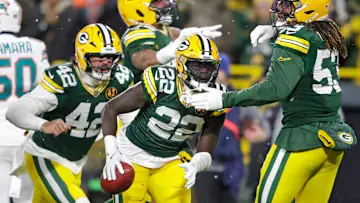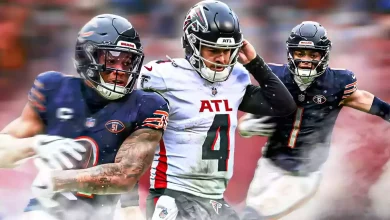Sweet 16: Vote for Best Player in Green Bay Packers History

Who will cut down the nets and enjoy one (more) magic moment as the best player in Packers history? That’s for you to decide. We have taken 16 titans of the franchise – a Sweet 16 that includes 13 Pro Football Hall of Famers – and placed them into four position-based regions.
Here are the matchups. Voting will be done on X at the links below.
Quarterbacks Regional
1. Bart Starr vs. 4. Lynn Dickey
No team has enjoyed better quarterback play than the Packers. This is the equivalent of No. 1 vs. No. 16, though, with the legendary Bart Starr against Lynn Dickey, who got into the bracket over Arnie Herber, who was the all-1930s quarterback and the first player in NFL history to throw for 1,000 yards in a season.
Dickey was a tremendous passer. During his best seasons, he led the Packers to a lot of points; the problem was the defense allowed even more. His best season came in 1983, when he led the NFL with 4,456 passing yards and 32 passing touchdowns to finish fifth in NFL MVP voting. In nine seasons with the team, he threw for 21,369 yards and 141 touchdowns.
Starr, despite piloting the Packers to five NFL championships and the last three-peat, is the quarterback that time forgot. Penalized for the sin of playing with several Hall of Famers, Starr was the 1966 NFL MVP, the Hall of Fame’s all-1960s quarterback and a two-time Super Bowl MVP. Talk about dominance: During that MVP season, his passer rating was 105.0; no other quarterback hit 90.0 and the league average was 67.4. In an era that was not friendly to quarterbacks, his playoff stats have withstood the test of time.
2. Brett Favre vs. 3. Aaron Rodgers
Talks about a clash of the titans. Brett Favre won three NFL MVPs and one Super Bowl. Aaron Rodgers replaced Favre and won four MVPs and one Super Bowl.
Favre, who won MVP honors in 1995, 1996 and 1997, was the Hall of Fame’s all-decade quarterback for the 1990s. He led the league in passing yards twice and passing touchdowns four times and ranks fourth all-time in those categories. The stats are impressive, but Favre wasn’t just about numbers. With a gunslinger mentality, he helped resurrect a dormant franchise, kicking off a three-plus-decade run of winning football.
Rodgers, the Hall of Fame’s all-decade quarterback for the 2010s, somehow raised the bar from Favre. He is the NFL’s all-time leader in passer rating. While Favre is No. 1 all-time in interceptions thrown, Rodgers is No. 1 for lowest interception percentage. After a couple down years to end the Mike McCarthy era, Rodgers experienced a career rebirth with Matt LaFleur in winning MVP in 2020 and 2021, when he threw a combined 85 touchdowns and nine interceptions.
Receivers Regional
1. Don Hutson vs. 4. Davante Adams
No team can match the Packers’ history at quarterback. The history is rich at receiver, too, with Davante Adams getting into the bracket over the likes of Donald Driver, Jordy Nelson, Greg Jennings and Billy Howton.
Don Hutson played 11 seasons and helped revolutionize the position and sport. He was second-team All-Pro the first three seasons and first-team All-Pro the last eight. He led the NFL in receptions eight times, receiving yards seven times and receiving touchdowns nine times. In 1942, he caught 74 passes for 1,211 yards and 17 touchdowns. In the 10-team NFL, Hutson had more receiving yards than four teams and more receiving touchdowns than eight. His 99 career receiving touchdowns stood as the NFL record for almost a half-century.
In eight seasons in Green Bay, Adams caught 669 passes for 8,121 yards and 73 touchdowns. Those numbers rank second, fourth and second, respectively, in franchise history. He was a Pro Bowler for each of his final five seasons in Green Bay, including first-team All-Pro in 2020, when he led the NFL in touchdowns and receiving yards per game, and 2021. He ranks 22nd in NFL history with 103 touchdowns.
2. Sterling Sharpe vs. 3. James Lofton
It’s a battle of a couple Hall of Famers, with Sterling Sharpe one of the most dominant receivers during a too-short NFL career and James Lofton one of the most explosive players of all-time.
Sharpe played only seven seasons. He led the NFL with 90 receptions in 1989, set the NFL record with 108 receptions in 1992 and broke it with 112 receptions in 1993. In 1994, his final season in the league, he caught 18 touchdown passes, tied with Davante Adams and Mark Clayton for third-most in NFL history.
Lofton caught 764 passes for 14,004 yards and 75 touchdowns in 16 seasons. He led the NFL in yards per catch in 1983 and 1984 and remains the all-time leader with 17.9 yards per touch. That record might never be broken; Henry Ellard (16.6) and Charlie Joiner (16.1) are the only players within 2 yards of Lofton. A marvel, Lofton had a 1,000-yard season with the Bills in 1991 at age 35.
Backs Regional
This bracket incorporates running backs, cornerbacks and linebackers.
1. Charles Woodson vs. 4. Herb Adderley
Hall of Famers Charles Woodson and Herb Adderley are two of the greatest cornerbacks in NFL history. Adderley got the nod over another Lombardi-era defensive back, Hall of Fame safety Willie Wood.
Woodson, an all-around sensational player, resurrected his career in Green Bay. During his final four seasons in his first stint with the Raiders, he intercepted six passes. In seven seasons with the Packers, he had at least seven interceptions in four, including an NFL-leading nine in 2009, when he was first-team All-Pro and NFL Defensive Player of the Year, and a league-best seven in 2011, when he was first-team All-Pro again. All-time, Woodson ranks fifth with 65 interceptions and second with 11 pick-sixes, and he added 33 forced fumbles and 20 sacks.
In nine seasons with the Packers, Adderley was first-team All-Pro five times (and a second-team choice in two others). He intercepted 39 passes with Green Bay, seven of which he returned for touchdowns. Plus, he was an excellent kickoff returner, especially early in his career. Adderley was a starter on six NFL championship teams. In Super Bowl II, he had a 60-yard pick-six against the Raiders. Including three seasons with the Cowboys, Adderley had 48 interceptions plus five more in the playoffs.
2. Jim Taylor vs. 3. Ray Nitschke
Jim Taylor is the only running back in the bracket, with Ahman Green on the wrong side of the bubble, and Ray Nitschke is the only linebacker in the field.
Taylor was the NFL’s most dominant runner not named Jim Brown. From 1960 through 1964, he had five consecutive 1,000-yard seasons. In 1962, he snapped Brown’s reign as NFL rushing champion as he led the NFL with 1,474 rushing yards, 19 rushing touchdowns and 105.3 rushing yards per game en route to winning NFL MVP. In nine seasons in Green Bay, Taylor rushed for 8,207 yards – a franchise record until Ahman Green returned to the team in 2009. His 81 rushing touchdowns are 27 more than any other player.
There’s no record of how many tackles Nitschke made or fumbles that he forced. In 1969, Pro Football Hall of Fame voters voted for the NFL’s all-time team through the first 50 years. Nitschke, even though he was only a one-time Pro Bowler, was the only linebacker selected. In 1994, the NFL selected a 75th-anniversary team. Nitschke was one of four linebackers on that squad. Really, Nitschke could have made this Sweet 16 for a practice-field incident in 1960. A steel coaching tower tipped over in the wind and landed on Nitschke. A spike put a hole in Nitschke’s helmet – it’s on display at the Packers Hall of Fame – but he continued practicing.
Linemen Regional
1. Reggie White vs. 4. Willie Davis
It’d be a race to the quarterback between these two pass-rushing titans. Reggie White ranks second in NFL history with 198 sacks, two behind Bruce Smith’s all-time record of 200. Sacks didn’t become a stat until 1982. Unofficially, Willie Davis finished with 99.5 – or maybe more.
White – the perfectly nicknamed “Minister of Defense” – already was a legendary player when he signed with the Packers in 1993. In eight seasons with the Eagles, he recorded 124 sacks, including NFL-best totals of 21 sacks in just 12 games in 1987 and 18 sacks in 1988. With the Packers from 1993 through 1998, he was first- or second-team All-Pro all six seasons. In 1996, White had “only” 8.5 sacks but he had three in the Super Bowl win over New England. In 1998, he was the NFL’s Defensive Player of the Year with 16 sacks.
Defensive stats are sparse for most of NFL history, including the 1960s, when Davis dominated. Davis was first-team All-Pro five times during a span of six consecutive Pro Bowl seasons. He was a starter for all five of the Glory Years championships, including serving as defensive captain of both Super Bowl championship teams. According to Pro Football Reference, Davis was second in the NFL with 14.5 sacks in 1964, fourth with 13 sacks in 1962 and in the top 10 in seven seasons.
2. Forrest Gregg vs. 3. Cal Hubbard
Seven offensive tackles were selected to the NFL’s 100th anniversary team. Forrest Greg and Cal Hubbard were among them.
Gregg played 15 seasons for the Packers. He was a first-team All-Pro seven times. From 1956 through 1971, he played in what was a league-record 188 consecutive games. While there’s no record that legendary coach Vince Lombardi called Gregg the “best player I ever coached,” he’s undoubtedly one of the best blockers in NFL history. Three tackles were selected to the NFL’s 75-year team. Gregg was one.
Hubbard was a key part of the NFL’s first three-peat, playing on both sides of the ball during the NFL’s ironman era. Hubbard was named to the NFL’s all-1920s team, then was a first-team selection for the first All-Pro teams in 1931, 1932 and 1933. As part of the NFL’s 50th-anniversary team in 1969, he was named the best tackle in NFL history. He was named to the NFL’s all-time two-way team as part of the 75th-anniversary team in 1994. Hubbard also is enshrined in the Baseball Hall of Fame for his work as an umpire.




